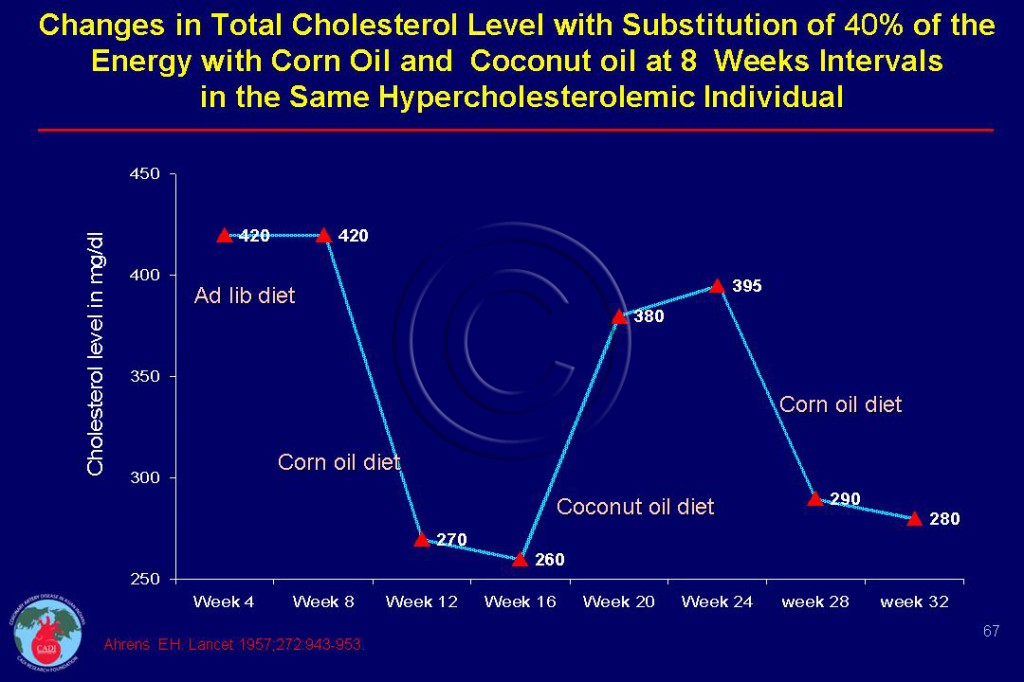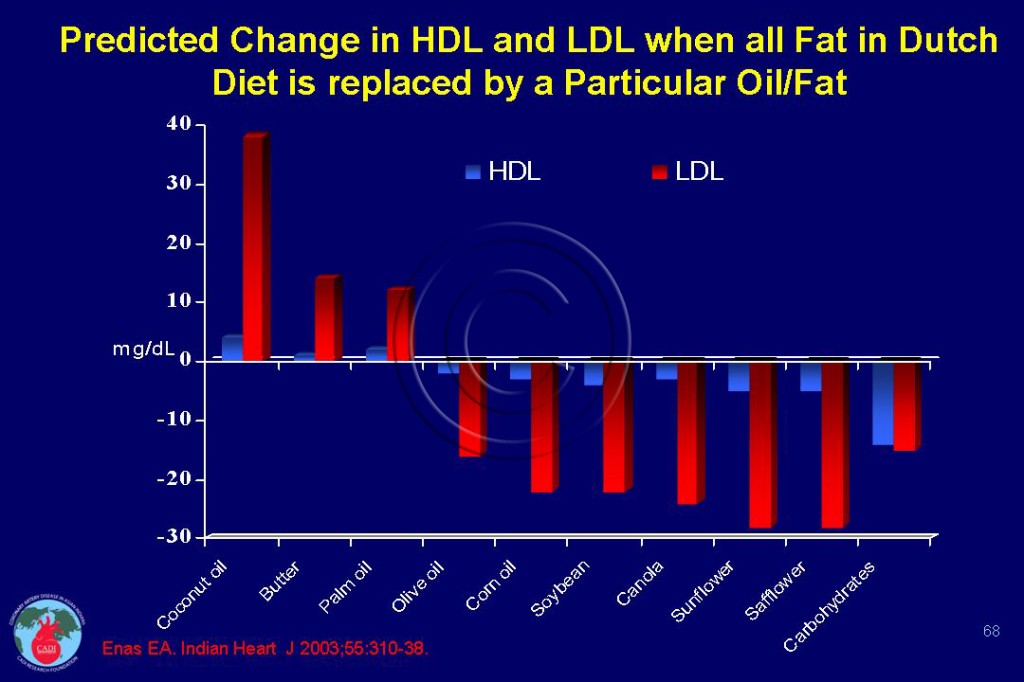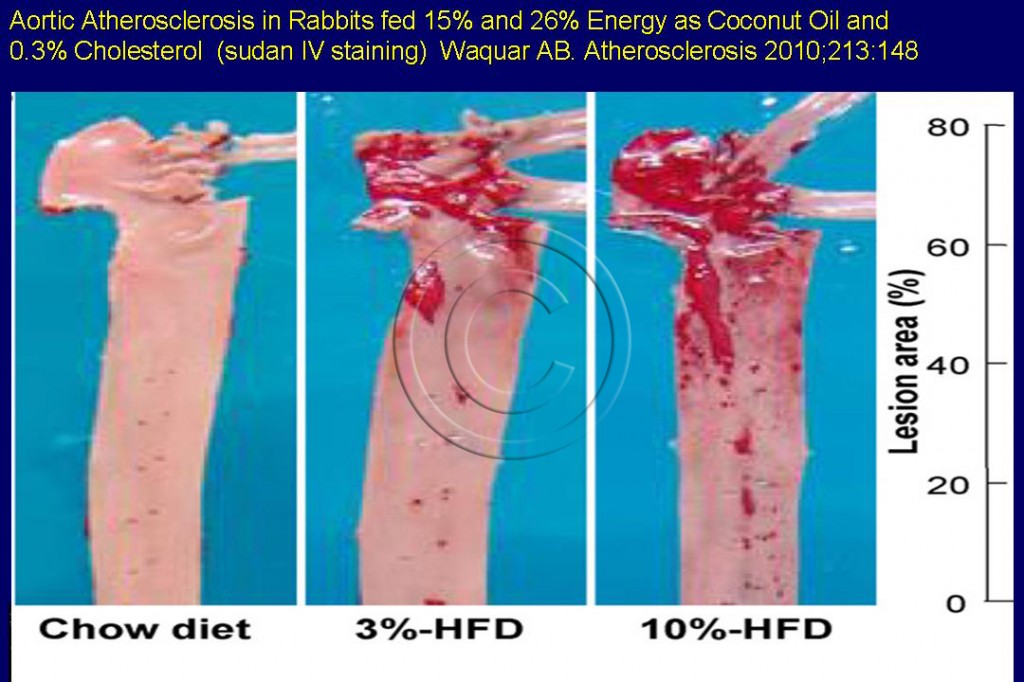Coconut─ More Dangerous than you Thought
- International differences in heart attack rates are best explained by a difference in blood cholesterol level than any other factor.1 The foremost determinant of high total cholesterol (TC) level is the consumption of saturated fat (SAFA), which is abundant in all edible coconut products (meat, milk, and oil).
- Several studies in animals and humans have established that SAFA increased blood cholesterol levels whereas polyunsaturated fatty acids (PUFAs) decrease cholesterol levels. A change of 10% energy from SAFA can change total cholesterol (TC) by 22mg/dl. SAFA (12-16 carbons) have twice the cholesterol raising influence as PUFA has in lowering it.2 Repeatedly substituting 40% of energy from corn oil with coconut oil and back to corn oil for eight weeks has been shown to change the blood cholesterol level by 135-160 mg/dl in the same individual (see Figure 067).3
- Coconut oil has the unique distinction of having the highest proportion of saturated fat (92%) and cholesterol-raising (12-16 carbons) SAFA (74%) compared to 53% in butter fat and 24-29% in the beef, pork, lamb, and chicken fat.2, 4-6 Specifically, coconut oil contains 47% lauric (C12), 18% myristic (C14), and 9% palmitic (C16) acid.2, 4-6
- Substitution of 1% of energy from carbohydrates to lauric acid increases cholesterol by 1 mg/dl. The figures for myristic acid and palmitic acid are 2.3 mg/dl and 1.5 mg/dl respectively.2, 7, 8 Thus the lauric acid does raise cholesterol though less than with myristic acid. Contrary to popular belief, the fiber in the coconut meat does not help blunt its cholesterol raising effects Figure 068.2
- One table spoon (14 gm) of coconut oil contains 126 calories of total fat of which 93 calories is cholesterol-raising SAFA.4 Although coconut products does raise HDL the LDL-C raising is several times higher.9
- Coconut is the principal agent used for producing experimental atherosclerosis.10 Waqar et al. have demonstrated that the intake of saturated fat in the form of coconut oil with a normal number of calories is detrimental to glucose and lipid metabolism.10 The enhanced atherosclerosis on rabbits fed 26% energy from coconut compared to 15% and normal chow is given in Figure 069. 10
- Rabbits fed a commercial chow diet containing 0.5% cholesterol and 14% coconut oil developed more severe dyslipidemia and atherosclerosis than rabbits fed the same diet containing olive oil instead of coconut oil. Average plasma total cholesterol was 2-fold and triglycerides 20-fold higher in the coconut oil-fed rabbits than in the olive oil-fed rabbits.11 Insulin resistance was manifested by high blood pressure, high blood sugar, and high insulin levels. There was also hyperplasia and hypertrophy of beta cells in the pancreatic islets.10, 12
- The striking finding of the development of visceral obesity and insulin resistance and in the absence of caloric excess is worth highlighting. This has enormous clinical relevance among people who consume large quantities of coconut products as discussed below.
- Kerala, renowned for the universal and liberal consumption of coconut meat, milk and oil, not only has the highest level of total cholesterol in India, but also the highest rate of CAD, diabetes, and metabolic syndrome.13, 14 The proportion of subjects with high total cholesterol (>240 mg/dL) in Kerala is double that of the U.S. (32% versus 15%).15 The average cholesterol in Kerala is 30-40mg higher than the rest of India (see Kerala Paradox and Kerala Heart Disease).16, 17 The use of coconut oil as a cooking medium has not spread beyond Kerala and its adjoining areas.
- In Sri Lanka, which also has a very high rate of CAD, about 80% of the fat in the habitual diet comes from coconut.18
- Coconut meat and milk are universal ingredients of cooking in Kerala accounting for a greater proportion of saturated fat consumption than from coconut oil. 3 oz of coconut meat or 3oz of coconut milk contains 12-14g of saturated fat─ the same amount as in one tablespoon of coconut oil. This amount alone provides the saturated fat allowance for the whole day for most individuals.
- One serving of coconut rich foods such as palappam, vattaappaam and vegetable thoran and even fish curry may contain no coconut oil, but may contain more than a day’s allowance of saturated fats.19 Failure to account for the liberal consumption of coconut meat may account for the discordant results of studies from Kerala and elsewhere.4 The calories from 100 grams of fresh and dry coconut are 444 and 662 respectively with most of it being from saturated fats.23 (for detailed info on most of the Indian foods and latest Dietary Guidelines for Indians click here)
- It’s worth emphasizing that the harmful effect of passive smoking cannot be documented among active smokers. A similar phenomenon occurs among Keralans, all of whom use liberal amounts of coconut meat and milk.
- Cholesterol-raising effects of coconut oil are similar or higher than that of butter and meat.7, 20 In a comparative study of diets rich in beef fat vs. coconut oil, the plasma total cholesterol, LDL, and HDL responses were lower with beef fat than coconut oil commensurate with the lower proportion of cholesterol-raising saturated fat in beef (29%) than coconut oil (74%).21
- When 22% of the energy intake in a Malaysian diet, high in palm oil, was substituted with coconut oil, there was an increase of 40 mg/dL in total cholesterol, 29 mg/dL in LDL, 36 mg/dL in triglycerides and 4 mg/dL in HDL.22
- Substituting 21% of daily energy from a high-beef American diet among medical students resulted in 13 mg/dL increase in total cholesterol (TC) with high coconut diet and 14 mg/dL decrease in TC with a high safflower oil diet.21
- Since coconut milk and oil have the highest proportion of saturated fat, the use of these products should be limited to <1 tablespoon a day even when the diet contains no other sources of saturated fat.4
- Almost 50% of the total coconut production is now consumed as tender coconut and coconut- based products other than coconut oil and copra. Unlike the coconut meat and milk, tender coconut water is a nutrient rich healthy drink and its use should be encouraged.
- Coconut is God’s food in India where 90 million coconuts are offered to Ayyappa in just one temple in Kerala (Sabarimala Ayyappan).
- The <7% of daily energy intake from SAFA equals 12 g for a1500 cal diet. One table spoon (14 g) of coconut oil or one-third cup (80 g or ml) of coconut milk provides 126 cal of which 93 calories come from LDL-C raising SAFA.
- Liberal use of all coconut products except tender coconut water should be discouraged along with all other sources of saturated fat.
FAQ
Q. Are there any health benefits from tender coconut water or does it do any harm?
A. Coconut water extracted from fruit too young to have formed milk is low in calories, and sugar than most juices. It contains the same five electrolytes found in human blood and has more electrolytes than Gatorade which contains only two. It is also an excellent fluid to rehydrate, especially useful in overcoming hangover.
Sources
1. Verschuren WMM, Jacobs D, Bloemberg B, et al. Serum total cholesterol and long-term coronary heart disease mortality in different cultures: Twenty-five year follow-up of the Seven Countries Study. JAMA. 1995;274:131-136.
2. Saturated fatty acids in vegetable oils. Council on Scientific Affairs. Jama. Feb 2 1990;263(5):693-695.
3. Ahrens E. H. J, Insull W, Jr., Blomstrand R, Hirsch J, Tsaltas TT, Peterson ML. The influence of dietary fats on serum-lipid levels in man. Lancet. May 11 1957;272(6976):943-953.
4. Enas EA, Senthilkumar A, Chennikkara H, Bjurlin MA. Prudent diet and preventive nutrition from pediatrics to geriatrics: current knowledge and practical recommendations. Indian Heart J. Jul-Aug 2003;55(4):310-338.
5. Enas EA. How to Beat the Heart Disease Epidemic among South Asians: A Prevention and Management Guide for Asian Indians and their Doctors. Downers Grove: Advanced Heart Lipid Clinic USA; 2011.
6. Enas EA. Indian diet and cardiovascular disease: An update. In: Chatterjee SS, ed. Update in Cardiology Hyderabad: Cardiology Society of India.; 2007.
7. Cox C, Mann J, Sutherland W, Chisholm A, Skeaff M. Effects of coconut oil, butter, and safflower oil on lipids and lipoproteins in persons with moderately elevated cholesterol levels. J Lipid Res. Aug 1995;36(8):1787-1795.
8. Grundy SM, Denke MA. Dietary influences on serum lipids and lipoproteins. J Lipid Res. 1990;31(7):1149-1172.
9. Katan MB, Zock PL, Mensink RP. Dietary oils, serum lipoproteins, and coronary heart disease. Am J Clin Nutr. Jun 1995;61(6 Suppl):1368S-1373S.
10. Waqar AB, Koike T, Yu Y, et al. High-fat diet without excess calories induces metabolic disorders and enhances atherosclerosis in rabbits. Atherosclerosis. Nov 2010;213(1):148-155.
11. Van Heek M, Zilversmit DB. Evidence for an inverse relation between plasma triglyceride and aortic cholesterol in the coconut oil/cholesterol-fed rabbit. Atherosclerosis. Jun 1988;71(2-3):185-192.
12. Kubota N, Terauchi Y, Miki H, et al. PPAR gamma mediates high-fat diet-induced adipocyte hypertrophy and insulin resistance. Mol Cell. Oct 1999;4(4):597-609.
13. Kutty VR, Balakrishnan KG, Jayasree AK, Thomas J. Prevalence of coronary heart disease in the rural population of Thiruvananthapuram district, Kerala, India. Int J Cardiol. 1993;39(1):59-70.
14. Reddy KS, Prabhakaran D, Chaturvedi V, et al. Methods for establishing a surveillance system for cardiovascular diseases in Indian industrial populations. Bull World Health Organ. Jun 2006;84(6):461-469.
15. Joseph A, Kutty VR, Soman CR. High risk for coronary heart disease in Thiruvananthapuram City: A study of serum lipids and other risk factors. Indian Heart J. 2000;52(1):29-35.
16. Thankappan K R, Shah B, Mathur P, et al. Risk factor profile for chronic non-communicable diseases: results of a community-based study in Kerala, India. Indian J Med Res. Jan 2010;131:53-63.
17. Shah B, Mathur P. Surveillance of cardiovascular disease risk factors in India: the need & scope. Indian J Med Res. Nov 2010;132(5):634-642.
18. Mendis S, Samarajeewa U, Thattil RO. Coconut fat and serum lipoproteins: effects of partial replacement with unsaturated fats. Br J Nutr. 2001;85(5):583-589.
19. Package label from imported food from Kerala. 2011.
20. Cox C, Sutherland W, Mann J, de Jong S, Chisholm A, Skeaff M. Effects of dietary coconut oil, butter and safflower oil on plasma lipids, lipoproteins and lathosterol levels. Eur J Clin Nutr. Sep 1998;52(9):650-654.
21. Reiser R, Probstfield JL, Silvers A, et al. Plasma lipid and lipoprotein response of humans to beef fat, coconut oil and safflower oil. Am J Clin Nutr. Aug 1985;42(2):190-197.
22. Ng TKW, KC H, Dewitt GF. Dietary palmitic and oleic acids exerts similar effects on serum cholestrol and lipoprotein profiles in normocholestrolemic men and women. J Am Coll Nutrition. 1992;4:383-390.
23. NIN. Dietary guidelines for Indians. Hyderabad: National Institute of Nutrition;2011.




